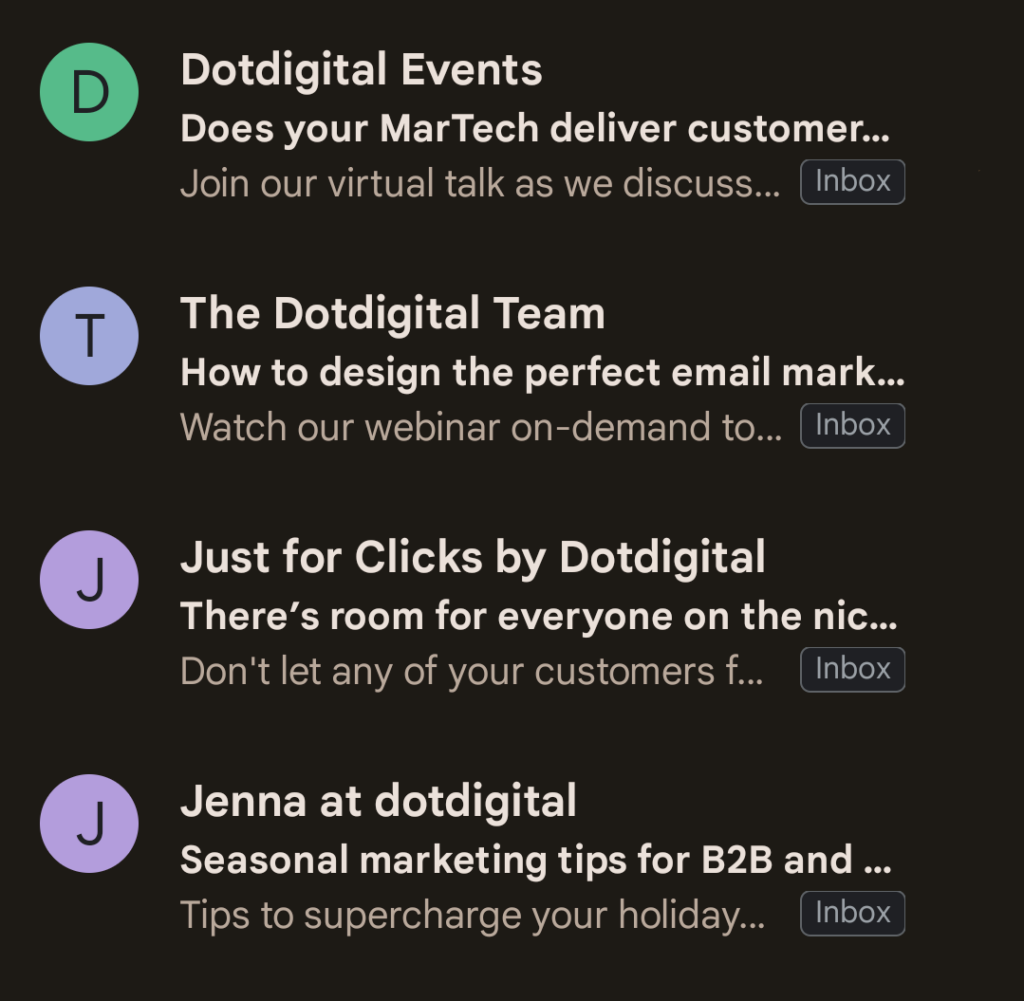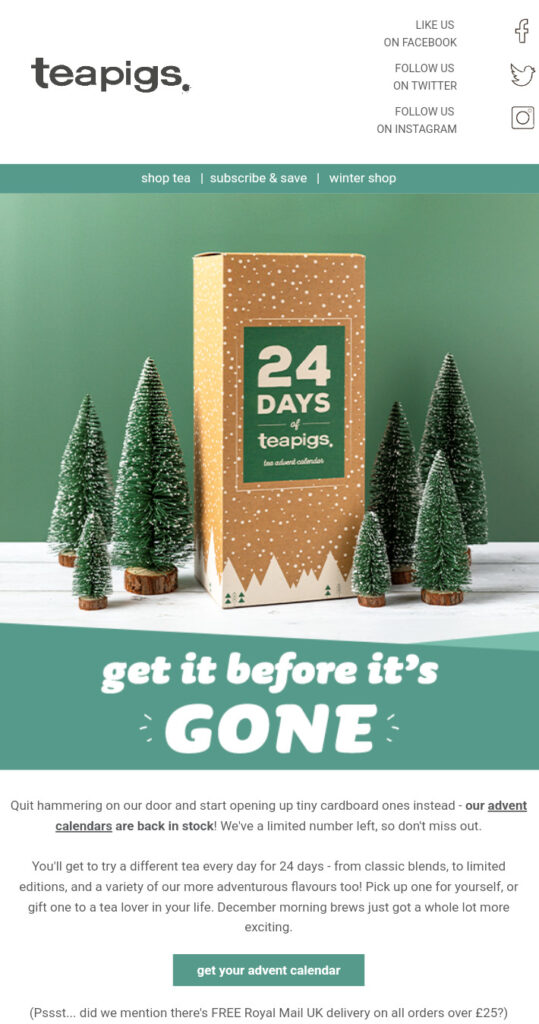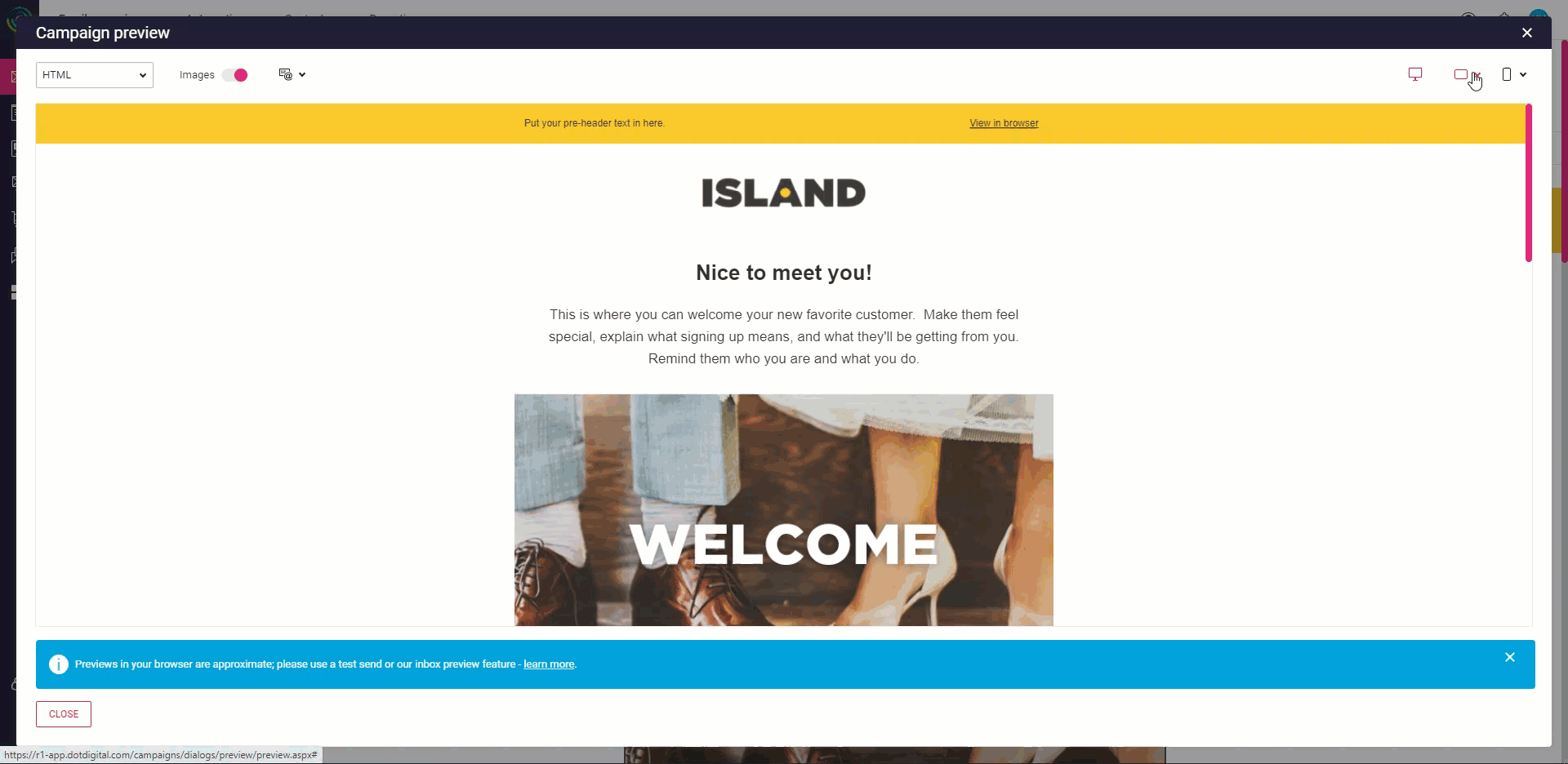10 email marketing optimization strategies

Email is a great channel, that’s nothing new. Marketers using Dotdigital see an ROI of 409%, making it an obvious channel to focus on. Especially at a time when you need marketing budgets need to do more with less.
To get the most from email marketing, you need to be continually optimizing. Something as simple as having an emoji in your subject line, can add up to a huge improvement in your campaign’s success.
We’re sharing 10 strategies you can implement to optimize every stage of your email’s journey, in order to elevate your campaigns. Let’s get into it.
1. Maximize your subject line and pre-header
Let’s start at the beginning. Your subject line and pre-header are the first thing your audience will see, and will determine whether they open your campaign or not.
You need to write subject lines that get opened, so this copy needs to be enticing and intriguing enough to make customers click. Use your subject line and pre-header to let subscribers know what they can expect from your campaign. Including a CTA in your subject line, such as ‘join us’ or ‘shop now’ will help prompt the reader.
Ensure that the subject line is relevant to the content of your email. You also need to be concise, aim for around 30-50 characters for your subject line, and 50-100 characters for your pre-header.
Ultimately, with subject lines, there are no hard and fast rules. Test what works for your audience, whether that’s emojis, puns, discounts, asking a question, and so on. Standing out in a busy inbox is no easy feat, so get creative.
2. Test your friendly from name

Still on the ‘outside’ of your email, and determining if it’s worth opening or not, is your friendly from name. Whilst brand name alone can be enough to get opens, others may need more to grab attention.
You can switch up your friendly from name to include the team or topic. At Dotdigital, we often test this, trying friendly from names such as ‘events at Dotdigital’, or including a person which adds a human touch, for example ‘Jenna at Dotdigital’. This works great if you send out lots of different style emails and want to make it easily identifiable to your customers.
3. Optimize your send time
The time you send your email could make all the difference between a commuter looking for something to kill time, or a busy parent preparing dinner who’ll swipe your campaign away without a second thought.
This is something you can and should test, as it may be different for each of your contacts. Dotdigital makes it super easy for you to optimize your send times. Send time optimization uses AI technology to find the best time to send, based on your contacts’ historical click behavior. It then triggers individual sends at this time, to maximize engagement. Clever, right?
4. Utilize personalization

Once you’ve got the open, you need your campaign to grab the recipient’s attention. Personalization is where you use data fields to pull in relevant data belonging to the customer. This could simply be their first name to add authenticity and mimic real-life conversations. Another example is using the customers’ location in the campaign, such as calling out the nearest store to them. AI-powered product recommendations are also a great form of personalization; showing customers items they’re likely to buy, based on their previous purchasing behavior.
Personalization is a great way to make your customers feel valued and understood, especially in an inbox full of generic messaging. Plus, if it’s useful content like product recommendations or store information, it’s going to make their life easier too.
5. Provide dynamic content
Hand in hand with personalization is dynamic content. This a form of personalization in that it shows customers content that is relevant to them, and works by having rules set up within a campaign. You can create your campaign to show different variations of content corresponding to customers’ data fields. This could look something like: show content block A if data field: ‘recently bought’ is equal to: ‘sweaters’. Always ensure you have a default variation when creating dynamic content, and be sure to test a few out in the preview functionality.
Dynamic content allows you to set up one campaign, but have sections of it tailored to each recipient. Providing content that is super-relevant to the user will both increase your odds of a click-through to site, and create a better customer experience too – thereby generating loyalty.
6. Elevate your copy

Use compelling copy in your campaigns. The words in your emails are what brings the campaign to life.
Steer away from big chunks of text. Instead, keep things easy to read. Use of headers to break up your copy or signpost your content and make sure your language is simple and easy to understand. Make it skimmable for those short on time, do this with bullet points, bold certain words or phrases, capital letters to draw attention (sparingly), and using clear headers where appropriate.
You should also test your CTAs; look at in-text links vs buttons. Consider the copy within your CTA buttons too. The seemingly small difference between ‘buy now’ and ‘learn more’ can actually indicate a different stage of the journey and alienate some customers.
Optimization is all about drilling into the detail and considering seemingly simple things. Recognizing that they can have a big impact on the overall success of your campaign.
7. Encourage preferences and unsubscribes
Email is a great channel because you can tailor your content. And the best way to find out what your customers want? Ask them.
It’s that simple. Ensure you have a preference center, and signpost it to your customers. This lets you create a menu of content, and lets them tell you what piques their interest. Then you can use this information to plan your content, and send relevant, enjoyable content out to your subscribers.
Similarly, if a customer isn’t enjoying your content, let them go. Your brand won’t be for everyone, and it won’t be forever. People’s needs and wants change, and some degree of list churn is healthy. Good data hygiene means a better marketing list with engaged customers which leads to better engagement overall. So don’t hide that unsubscribe button, as you’re then risking reputation damage and being marked as spam.
8. Consider different devices

Your email will look different depending on the device it’s opened on. When creating and designing your campaigns you need to be aware of mobile, tablet, laptop, and desktop devices. Globally, 92% of internet users access the internet via mobile phone, 66.8% use a laptop or desktop, and 28.2% use a tablet. It’s important to know your audience and how they’re viewing your campaigns. With Dotdigital, you can easily find this information in your campaign analytics.
Ensure you have adaptable templates, so that your campaign looks great no matter the device. Dotdigital’s easy editor email builder does this for you automatically. You can also preview how your campaign will look on multiple devices, as well as being able to switch between portrait and landscape view.
9. Improve your automations
Another important area to optimize is your automations. When you’re a busy marketer, it’s easy to ‘set and forget’, but you need to check back in regularly. Dig deep into your program reporting, to see how many users entered the program, the path taken, campaigns sent, and a whole host of other metrics. You should also look at the individual campaigns within the program, just like you would any other send. See where users are clicking, unsubscribing, converting, and then optimize accordingly.
A great way to continually optimize is to run A/B tests on your automation programs. Once your campaign has run long enough to create statistically significant data, update the A/B test to the winning version and a new variable.
Not every test will have a clear winner, and oftentimes you’ll find the existing version continues to win. A/B testing is a learning curve, and every outcome is a learning experience. Continual improvement, no matter how small, will add up over time. Top tip: set a recurring calendar appointment with yourself to check in on automations as it’s so easy for them to slip down the to-do list.
10. Get reliable insights from reporting
The best way to optimize is to keep learning, and the best way to do that is to delve into your data. Use trackable links and utilize the reporting suites available to you to get the full picture on your activity. Look at campaign reporting regularly, and use this insight to inform future sends.
Reporting isn’t just looking at campaigns, but looking at customer insights too. Single customer view brings together all the data you hold on a contact into one easy-to-view place. From this, you can create lookalike segments which groups contacts based on shared characteristics and behaviors.
For more insights into your customers, utilize the persona movement report to see how customer groups have changed over a set date period, i.e. from engaged to unengaged. This is a great way of creating segments for hyper-relevant campaigns and programs.
Similarly, the opportunities dashboard allows you to see an overview of your customers and the stage they are at, based on their persona and engagement level. This insight allows you to take a step back and see from the data which opportunities to focus on.
Optimization takeaways
To get the most from your email marketing you need to test what works, and never stop optimizing. The digital marketing landscape changes, people change, the economy fluctuates, and trends come and go. For your campaigns to flourish, you need to continually check in and see what’s working, and what’s not.
Always stay one step ahead, and don’t get complacent. Test everything you can in order to find the perfect recipe for your customers. Remember that one brand’s winning formula will tank elsewhere, you really have to see what works for your brand and your customers.



